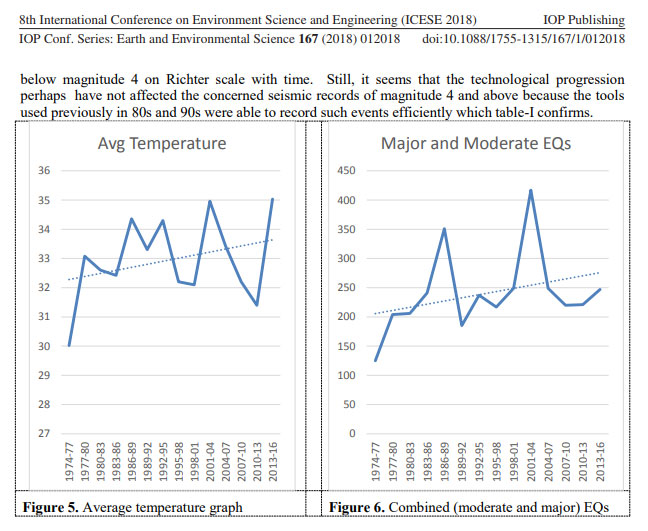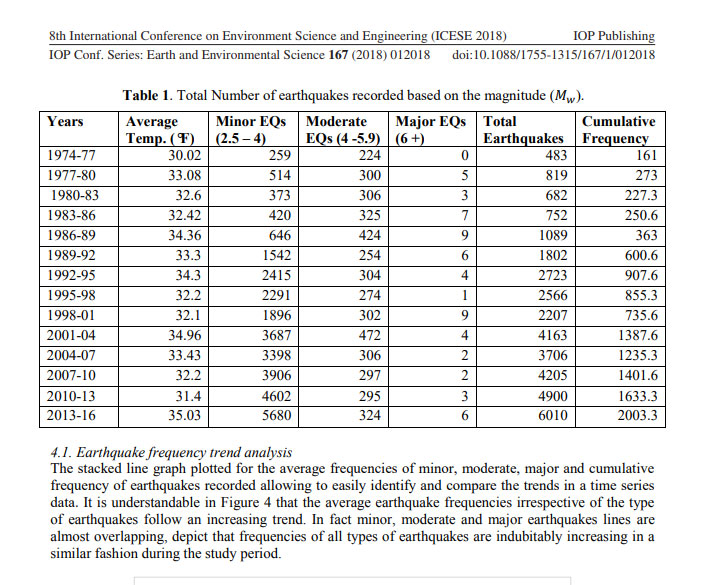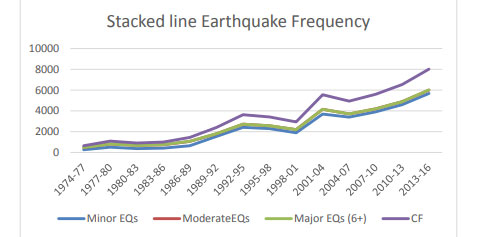Study: Enhanced Seismic Activity Observed in Alaska Due To Climate Change
With news breaking that Alaska just had its warmest March […]
Date Posted:
June 6, 2019
With news breaking that Alaska just had its warmest March to May on record with a statewide average temperature of 32.6°F, 8.6°F above the long-term average – the previous warmest spring in Alaska was in 2016, one must ask how this performs in relation to seismicity. First we learn that according to the University of Alaska Fairbanks 2018 Year in Review, the year recorded the most earthquakes to date.
Alaska Earthquake Center: We recorded more than 55,000 earthquakes in Alaska last year. We would give you an exact figure, but we’re still counting. That’s a record, and not by a little. The previous high was 42,989 in 2017, which eclipsed 2014’s record of 40,686. However, there was nothing extraordinary about 2017 seismically. The record was mainly due to the addition of 157 new USArray stations from 2014-2016, which helped us to detect far more earthquakes in previously uninstrumented parts of the state, especially in the north and west.
The 2018 study, An Enhanced Seismic Activity Observed Due To Climate Change: Preliminary Results from Alaska, notes:
Permafrost in Siberia and Alaska has started to thaw for the first time since it formed 11,000 years ago, has caused by the recent rise in temperature over the past six decades. The melting rate of glaciers has become significantly higher, causing a noticeable rise (0.19meters) in the sea level globally. Climate change can trigger catastrophes such as earthquakes, volcanic eruptions, tsunamis and landslides due to melting glaciers and rising in sea level. The melting of glaciers driven by global warming warns us of a seismically turbulent future. When glaciers melt, the massive weight on the Earth’s crust reduces and the crust bounces back in what scientists call an “isostatic rebound“. The process can reactivate faults and lift pressure on magma chambers that feed volcanoes, hence increases seismic activity.
The author further writes..
Introduction

It seems that rise in regional temperature due to global warming causing the glaciers to melt, which in turn depressurizing the underlying rocks, hence affecting the earth to rebound and faults to reactivate, therefore labeling the region seismically active with obvious increase in the frequency of volcanoes and earthquakes.
An enhanced volcanic activity has been observed due to deglaciation in Arctic has led to a hypothesis that the unloading of the glaciated ice in a volcanic terrains can increase volcanism through decompression melting in the shallow mantle or storage time reduction in crustal magma. Recently, the enhanced deglacial volcanic activity in Southeast Alaska sourced from Mount Edgecumbe Volcanic field has been correlated with the rapid isostatic adjustment, occurred following a retreat of regional glaciers. https://iopscience.iop.org/article/10.1088/1755-1315/167/1/012018/meta
We constrain the timing of this regional eruptive sequence to 14.6–13.1 ka. The sudden increase in volcanic activity from the MEVF coincides with the onset of Bølling–Allerød interstadial warmth https://www.sciencedirect.com/science/article/abs/pii/S0012821X16303892?via%3Dihub
Related Reading The Bølling-Allerød warming
The finding is consistent with the hypothesis that isostatic rebound is associated with ice-unloading which increases the volcanism, that can possibly influence the frequency of the earthquakes as well. A certain earthquake is related to climate change? Surely not, but the earthquake activity can be linked to climate change, at least in a mountainous region where glaciers form and later they melt.
The process introduces isostatic uplift and then will be a feedback between these processes. Glaciation of mountainous areas introduce extra load on Earth’s crust, which introduces stress in the crust. Depending on the rate of the isostatic uplift due to melting glacier and the composition of the underlying strata, these stresses can be released as landslides, ductile deformation and also as earthquakes.
Climate change and projected potential for seismic response

U.S. Arctic Research Commission reported that the consistent rise in the temperature is a serious concern in Alaska and Arctic because often melting of glaciers and permafrost due to air and surface warming lead to ground destabilization as well as ecosystem changes. According to Sujib Kar seismicity has been increasing due to global warming. Kar in an interview said that “If you look at the number of earthquakes of magnitude 5 or more in Richter scale from 2001 to 2015 in earthquake-prone areas, you will be able to comprehend the dynamics.
The rise of global temperature was phenomenal during this period”. He further added that the total number of earthquakes recorded in 2001 with magnitude 5 or more on Richter scale across the globe were merely 157, whereas the numbers for same type of events occurred in 2015 were nearly ten times higher – 1556. The trend according to the proposed hypothesis shows that rising temperature due to global warming in Alaska might have contributed to the sharply increased cumulative earthquake frequency in recent decades.
Bill McGuire, a professor of geophysical and climate hazards at University College London, in his book entitled “Waking the Giant” argues that, if the present trend of climate change driven by human continue, the temperature and sea level will rise as compared to post-glacial period, it would be a surprise if some of the countless faults under the subsurface did not respond to the new distribution of global water certain to occur as world continue to heat up. He told India Climate Dialogue that “it’s not a theory anymore, there is huge amount of evidence for the clear relationship between climate change and earthquakes particularly in Scandinavia and North America at the transition from the last Ice Age. The seismic response of ice unloading can clearly be seen in Alaska”.
McGuire argues that when climate changed naturally in the past and planet emerged from an ice age, large ice sheets covering in much of the planet retreated. They were so heavy that the resulting release of pressure on the earth’s crust caused it to ‘bounce back’ triggering earthquakes, tremors and even volcanic activity along preexisting fault lines. The last ice age occurred 20,000 years ago when temperature started rising caused large ice sheets to retreat, our Earth is still responding to that ice age and the crustal bounce back rate has been modeled.
Bill McGuire further elaborated on the interconnection between climate and seismicity in this 2016 talk:
Study Results

Deglaciation due to climate change promotes volcanism as discussed in section 1 which sources faults to reactivate. The effect of increased volcanic activity can be prominent in Alaska as most of the region is covered with glaciers melting at a high rate that can increase the frequency of earthquakes by reactivating pre-existing weak tectonic faults which makes the region sensitive to the changes like unloading heavy ice cover. Thus a sharp increase in the frequency of earthquakes from 2001 – 2016 can be correlated to NASA reported 15 hottest years since 2001 that has caused the glaciers and sea ice to melt at rapid pace and sea level to rise at a record rate of 85.5mm.
Earthquake behaviour is chaotic and skills for earthquake prediction are limited, however the rise in the frequency of small earthquakes is arguable as glaciers melt and sea level rises. Due to tremendous increase in the low magnitude earthquake records since 21st century beginning, the correlation coefficient between temperature and minor earthquakes was expected to be the strongest among all others, however interestingly, it is not even significant which reflects the technological progression of recent seismic station network expansion by USArray all over U.S.
On the other hand, rise in temperature showed a strong positive correlation with moderate earthquake records, whereas its significant correlation with major earthquakes at P < 0.12 (medium confidence) was totally a surprise. Furthermore, a combined effect of both moderate and major earthquakes was also considered against the temperature variations that startlingly represented even greater correlation value r than its value for moderate earthquakes which warns that the rate of isostatic rebound driven by melting glaciers due to regional rise in temperature of Alaska has become high enough to influence the subsurface tectonic plates and can yield both moderate and major earthquakes by reactivating the subsurface faults.
Results [..] suggest that even though the postglacial stress due to rapid shrinkage of sea ice cover and melting glaciers has not yet started influencing the major earthquakes of magnitude 6 or more on Richter scale much, however the noticeable rise in the frequency of moderate earthquakes of magnitude ranging from 4 to 5.9 points to a seismically turbulent future, if the present trend of glaciers and sea ice melting due to rise in temperature driven by anthropogenic activity remains the same, soon many of the countless subsurface faults will start responding in the form of major earthquakes.
Conclusions
Results [..] show that it [Global Warming] can significantly influence the subsurface tectonic plate moments through accelerated seismic activity as well. It seems that rise in regional temperature due to global warming causing the glaciers to melt, which in turn depressurizing the underlying rocks, hence affecting the earth to rebound and faults to reactivate, therefore labeling the region seismically active with obvious increase in the frequency of volcanoes and earthquakes.
Related Read: Evaluating the relationship between climate change and volcanism 2018 (PDF)
